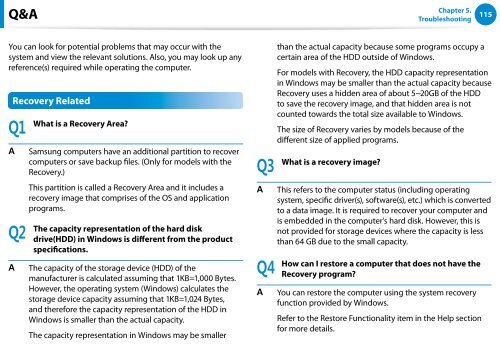Samsung Series 7 13.3” Notebook - NP740U3E-A01UB - User Manual (Windows 8) (ENGLISH)
Samsung Series 7 13.3” Notebook - NP740U3E-A01UB - User Manual (Windows 8) (ENGLISH)
Samsung Series 7 13.3” Notebook - NP740U3E-A01UB - User Manual (Windows 8) (ENGLISH)
You also want an ePaper? Increase the reach of your titles
YUMPU automatically turns print PDFs into web optimized ePapers that Google loves.
Q&A<br />
Chapter 5.<br />
Troubleshooting<br />
115<br />
You can look for potential problems that may occur with the<br />
system and view the relevant solutions. Also, you may look up any<br />
reference(s) required while operating the computer.<br />
Recovery Related<br />
Q1<br />
A<br />
Q2<br />
A<br />
What is a Recovery Area?<br />
<strong>Samsung</strong> computers have an additional partition to recover<br />
computers or save backup files. (Only for models with the<br />
Recovery.)<br />
This partition is called a Recovery Area and it includes a<br />
recovery image that comprises of the OS and application<br />
programs.<br />
The capacity representation of the hard disk<br />
drive(HDD) in <strong>Windows</strong> is different from the product<br />
specifications.<br />
The capacity of the storage device (HDD) of the<br />
manufacturer is calculated assuming that 1KB=1,000 Bytes.<br />
However, the operating system (<strong>Windows</strong>) calculates the<br />
storage device capacity assuming that 1KB=1,024 Bytes,<br />
and therefore the capacity representation of the HDD in<br />
<strong>Windows</strong> is smaller than the actual capacity.<br />
The capacity representation in <strong>Windows</strong> may be smaller<br />
Q3<br />
A<br />
Q4<br />
A<br />
than the actual capacity because some programs occupy a<br />
certain area of the HDD outside of <strong>Windows</strong>.<br />
For models with Recovery, the HDD capacity representation<br />
in <strong>Windows</strong> may be smaller than the actual capacity because<br />
Recovery uses a hidden area of about 5~20GB of the HDD<br />
to save the recovery image, and that hidden area is not<br />
counted towards the total size available to <strong>Windows</strong>.<br />
The size of Recovery varies by models because of the<br />
different size of applied programs.<br />
What is a recovery image?<br />
This refers to the computer status (including operating<br />
system, specific driver(s), software(s), etc.) which is converted<br />
to a data image. It is required to recover your computer and<br />
is embedded in the computer's hard disk. However, this is<br />
not provided for storage devices where the capacity is less<br />
than 64 GB due to the small capacity.<br />
How can I restore a computer that does not have the<br />
Recovery program?<br />
You can restore the computer using the system recovery<br />
function provided by <strong>Windows</strong>.<br />
Refer to the Restore Functionality item in the Help section<br />
for more details.
















